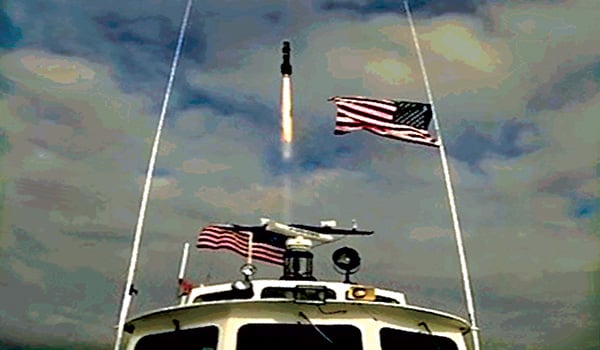
Arming the Force / By MG L. Neil Thurgood and COL James S. Romero: PEO Missiles and Space (PEO M&S) and the Joint Attack Munition Systems (JAMS) Project Office are mission focused to develop, field, and sustain versatile weapon systems for the U.S. Army, the Joint Force, and our coalition Warfighters providing a decisive combat advantage.

HELLFIRE launch illustration
Production of these weapons and improving them remain key aspects of providing critical capabilities to Warfighters ensuring the Army can effectively destroy current and future threats. The challenge we continue to face is being able to conduct modernization of existing equipment, develop new equipment, and plan for the future in a constrained environment. The JAMS Project Office is uniquely positioned to leverage these capabilities since we are the provider of weapons to so many customer groups, including Army, Air Force, Navy, Marines, Special Operations Command (SOCOM)(AFSOC, ARSOAC, MARSOC, and JSOC), and multiple coalition partners.
Modernizing the aviation weapons portfolio keeps our systems relevant in near-term, while we develop new systems and plan for the future. These efforts are focused on the Hydra and HELLFIRE family of rockets and missiles. Within the Hydra families of rockets our efforts are focused on the guided rocket option and other potential improvements to improve warhead performance. Similarly, in the HELLFIRE family of missiles, we are focused on keeping production on track while also supporting unique applications and leveraging other efforts to potentially improve the missile. The improvements we continue to make to HELLFIRE missiles are examples of this innovation. During the last fourteen years, working with many user groups, the Army developed and fielded more than five unique versions of the HELLFIRE missile to counter niche threats or allow their use in unique engagement scenarios. We developed fragmentation sleeves and unique warheads, with the “K2A” and other variants, to engage threats in the open. To fly the missile off-axis from unmanned aerial systems (UAS) platforms, we modified the missile guidance and controls, resulting in the “P2” and “P4” variants. To engage targets in structures we developed the “M”, “N”, and other versions with delayed detonation fuze options. Because of our relationships with all the user groups, we were able to leverage these unique capabilities and make these unique variants available to all the services.
We are also now applying this leverage and innovation concept to help Navy ships defend themselves with HELLFIRE Longbow missiles. The Navy has long needed a greater variety of weapons to defend ships against threats in littoral waters. As the Navy prepares to commission Littoral Combat Ships designed to operate in these waters, having more defensive capabilities to counter fast attack craft (FAC) and fast inshore attack craft (FIAC) remains a critical capability gap.

HELLFIRE Family of Munitions
EO M&S and PM JAMS have been working closely with the Navy, informing them of inherent capabilities of the Longbow fire-and-forget missiles, and teaming with them on demonstration test events, which in turn benefits the Army. Through this interaction, it is clear to the Navy that the Longbow missile, with its unique radar-guidance, is well suited to the task of destroying small threat boats in rapid succession, with lower user workload than current on-board weapons. As a result, the Navy has decided to integrate the Longbow missile on Littoral Combat Ships. We continue to work with the Navy and have modified the missile appropriately to be vertically launched and to effectively track targets over water. In addition to being very capable against small boats, this modified Longbow also has improved targeting capabilities against all targets and is still fully compatible with the Apache helicopter. This version of Longbow further expands Army capabilities and will help make more effective use of the large quantity of Longbow missiles in Army inventory.
Requirements
Another example of how we can improve capabilities with constrained resources is by establishing requirements that can result in early fielding at lower cost. By refining the guided rocket requirement to be met with a system that uses existing Hydra rocket launchers, the user representative opened the door to increased capability. While having lock-on-before-launch (LOBL) capabilities is still a recognized requirement, the Army decided this capability was not absolutely necessary for the initial capability. This is exactly how the Army was able to provide the Advanced Precision Kill Weapon System (APKWS) guided rocket to deployed units. With the help of the Aviation Center of Excellence and the Navy, PM JAMS was able to leverage the ongoing Navy/USMC program of record and get this new weapon to the field quickly.
Army leaders recognize the need to develop a greater variety of weapon systems to engage and defeat a broad range of targets. This increased variety will not only ensure we can destroy the full spectrum of targets, but will also increase our combat efficiency at the same time. The end result is that our forces are able to engage a greater number of targets with each armed platform, while increasing time-on-station and decreasing overall cost. This type of approach to requirements not only enables shortened fielding timelines at lower cost, but can also be a catalyst to future development work. During the lowest portions of the development funding cycle, major development programs will struggle to obtain resources. However, if requirements are sufficiently defined, this can help focus the limited funding provided by the science and technology enterprise.
Developing new systems, in the HELLFIRE Romeo and then JAGM, provides an even greater capability than the smaller modifications we have been able to make in aviation weapons. Having fielded many variants of HELLFIRE, we recognized that units in the field had to closely manage their weapons payload to match the expected threat. This resulted in more complexity for managing the missile inventory and for pilots to manage engagements in the fight. At the same time, we had already developed a very capable multi-purpose warhead in the Joint Air to Ground Missile (JAGM) program. Because of our relationships with user groups, we were able to combine requirements of all the HELLFIRE missile variants, to innovatively provide all these unique capabilities in one missile, with the multi-purpose warhead, resulting in the “R,” or Romeo version. Using this approach, we were able to significantly increase capabilities to all users and reduce inventory complexity, with very little development cost. This new version of HELLFIRE also set the stage for the JAGM program, which would further leverage this innovation by using the HELLFIRE back-end; motor, warhead, and other components. This has greatly decreased the risk, time, and funding required to get JAGM in the field. This leverage and innovation cycle has been the key underpinning to our ability to field new weapons with minimal funding and will continue to be the model we use for emerging capabilities.
Planning for the Future, we will focus on things we can do now to set the stage for future innovation. Despite the fiscal challenges we face, there are still opportunities to continue to innovate and improve the capabilities of our weapons. Through increasing partnerships with key stakeholders, we can leverage the Science and Technology (S&T) development work to benefit the Army and our Soldiers. Also, as we develop and field unique capabilities in response to urgent operational requests, we can find ways to get those unique capabilities into production and available for use by all US forces, not just for those who originally request or develop them. Additionally, future desired requirements can be shared earlier with industry to ensure they will be better informed on how to focus their Independent Research and Development (IR&D) funding. The end result is that, when the Army decides to fund a development effort, the technologies and subcomponents will be more mature and ready for integration. This will help decrease the risk, cost, and timeline while increasing opportunities for success and early fielding.
Modernizing, building new weapons systems and planning for the future in the current fiscal environment presents unique challenges. The HELLFIRE and Hydra programs have not had any research and development funding for over a decade, coupled with the effect of the Budget Control Act to decrease Army funding exacerbates the modernization funding outlook in the near future. Despite this challenging funding environment, we have been able to accomplish considerable improvements to our aviation weapons.
PEO M&S and PM JAMS have aggressively sought innovative techniques to expand, improve, and modernize the missiles, rockets, launchers, and equipment that it manages. These innovative approaches include seeking strategic partnerships with contractors and other program offices and, with the user’s help, refining requirements and creating a synergy across the many user representatives. We will continue these critical activities, but need the continued help and cooperation of all key stakeholders. Through stakeholder engagement we can further improve weapons available to Army Aviation with relatively modest investments. The JAMS portfolio of weapon systems is Army run, but truly joint in its nature, and this has been a great benefit to the Army, the Joint Force, and coalition forces.
We will continue to leverage the requirements synergy with the joint user community and will continue to develop and refine weapon systems and their capabilities to benefit all U.S. forces. Working closely with the Aviation Center of Excellence, PEO M&S and the JAMS Project Office will optimize the limited resources available during these fiscally constrained years and field weapons and associated equipment with improved lethality, range, and efficiency for use in all operational environments.
MG L. Neil Thurgood is the Program Executive Officer, Missiles and Space and COL James S. Romero is the Project Manager, Joint Attack Munition Systems both located at Redstone Arsenal, AL.





















